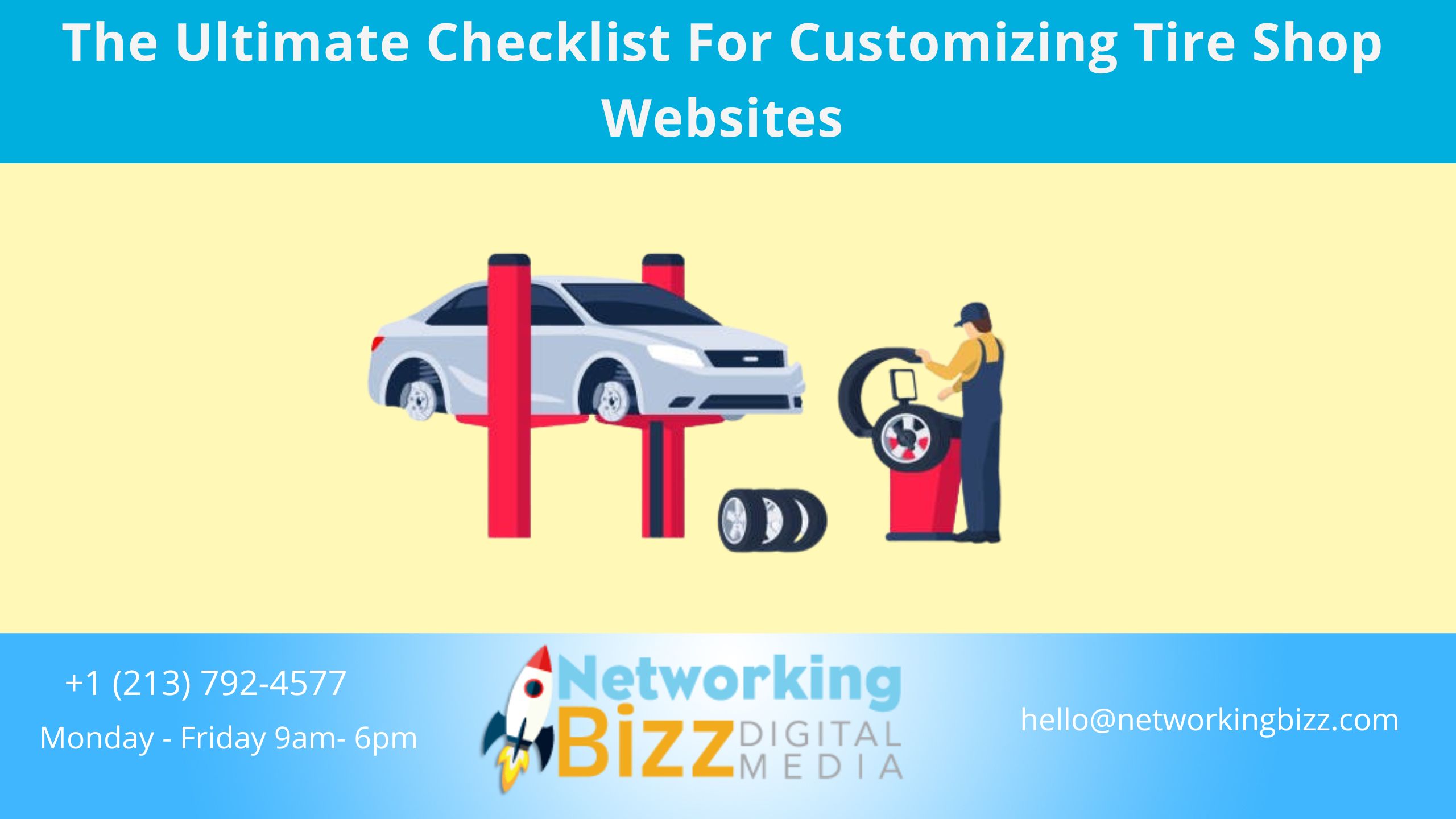Introduction
In today’s digital age, having a strong online presence is crucial for businesses to thrive. This holds true even for niche markets like tire shops. With more consumers turning to the internet to research products and services, tire shop owners must ensure that their websites are not only functional but also visually appealing and user-friendly. Customizing a tire shop custom website requires attention to detail and a strategic approach to stand out in a competitive market. In this comprehensive guide, we’ll delve into the ultimate checklist for customizing tire shop websites, covering everything from design elements to essential features, while also highlighting the importance of networking through platforms like Networking Bizz in at least 20 strategic places.
Understanding The Importance Of A Customized Website For Tire Shops
Before diving into the checklist, let’s first understand why customizing a tire shop website is essential.
Brand Representation: A customized website allows tire shops to showcase their brand identity effectively. From color schemes to typography, every element can be tailored to reflect the brand’s personality and values.
User Experience: A well-designed website enhances the user experience, making it easier for visitors to navigate through products and services. This ultimately leads to higher conversion rates and customer satisfaction.
Competitive Edge: In a saturated market, a customized website can help tire shops differentiate themselves from competitors. Unique features and personalized touches can attract and retain customers.
SEO Benefits: Customization enables optimization for search engines, improving the website’s visibility and driving organic traffic. This includes optimizing meta tags, URL structures, and content for relevant keywords.
Now that we understand the significance, let’s delve into the checklist for customizing tire shop websites.
The Ultimate Checklist For Customizing Tire Shop Websites
Networking Bizz offers wide range of custom website design services.
Professional Design
- Choose a clean and modern design that aligns with your brand.
- Use high-quality images and graphics to showcase products and services.
- Ensure responsive design for seamless viewing on all devices.
- Implement intuitive navigation for easy browsing.
Branding Elements
- Incorporate the tire shop’s logo prominently across the website.
- Maintain consistency in color schemes and typography.
- Use branded imagery and graphics to reinforce brand identity.
- Craft compelling taglines or slogans that resonate with the target audience.
Product Showcase
- Create dedicated pages for different types of tires and related services.
- Include detailed product descriptions, specifications, and pricing.
- Utilize high-resolution images to showcase tire options from various angles.
- Implement filters and search functionality for easy product discovery.
User-Friendly Features
- Integrate an easy-to-use booking or appointment scheduling system.
- Offer multiple payment options for customer convenience.
- Provide informative resources such as tire care tips and maintenance guides.
- Enable customer reviews and testimonials to build trust and credibility.
Local SEO Optimization
- Optimize website content with relevant local keywords (e.g., city name + tire shop).
- Claim and optimize Google My Business listing with accurate business information.
- Encourage positive reviews from satisfied customers to improve local search rankings.
- Create location-specific landing pages for targeting different regions.
Performance Optimization
- Minimize loading times by optimizing images and scripts.
- Enable caching and compression to enhance website speed.
- Regularly monitor and optimize website performance using tools like Google PageSpeed Insights.
- Ensure compatibility across different browsers and devices.
Security Measures
- Install SSL certificate to encrypt data and secure online transactions.
- Regularly update website plugins and software to patch security vulnerabilities.
- Implement strong password policies and use secure hosting services.
- Conduct periodic security audits to identify and mitigate potential risks.
Social Media Integration
- Include social media buttons for easy sharing of website content.
- Embed social media feeds to showcase user-generated content and engage visitors.
- Encourage visitors to follow the tire shop’s social media profiles for updates and promotions.
- Use social media advertising to target specific demographics and expand reach.
Mobile Optimization
- Prioritize mobile responsiveness to accommodate the growing number of mobile users.
- Optimize website layout and navigation for smaller screens.
- Test website performance on various mobile devices to ensure compatibility.
- Implement click-to-call functionality for easy contact on mobile devices.
Analytics and Tracking
- Integrate Google Analytics to track website traffic, user behavior, and conversions.
- Set up goals and event tracking to measure the effectiveness of marketing campaigns.
- Use data insights to make informed decisions and optimize website performance.
- Regularly review analytics reports to identify areas for improvement.
Content Strategy
- Develop a content strategy focused on providing valuable information to visitors.
- Publish blog posts on topics related to tires, automotive maintenance, and industry trends.
- Create engaging multimedia content such as videos and infographics.
- Optimize content for relevant keywords to improve search engine rankings.
Contact Information
- Display contact information prominently on every page of the website.
- Provide multiple contact options, including phone, email, and physical address.
- Use a contact form for visitors to submit inquiries or requests.
- Consider implementing live chat support for real-time assistance.
Testimonials and Reviews
- Showcase customer testimonials and reviews to build trust and credibility.
- Encourage satisfied customers to leave reviews on platforms like Google, Yelp, and Facebook.
- Respond promptly to both positive and negative reviews to demonstrate excellent customer service.
- Use testimonials strategically on landing pages and product pages to influence purchase decisions.
Accessibility Compliance
- Ensure website accessibility for users with disabilities, adhering to WCAG guidelines.
- Provide alternative text for images and audio/video content.
- Use semantic HTML markup for better screen reader compatibility.
- Conduct regular accessibility audits to identify and address any issues.
Legal Compliance
- Include necessary legal pages such as terms of service, privacy policy, and cookie consent.
- Comply with relevant regulations such as GDPR for handling customer data.
- Clearly outline refund and warranty policies to set expectations for customers.
- Consult with legal experts to ensure full compliance with applicable laws and regulations.
Networking Opportunities
Now, let’s delve into incorporating Networking Bizz into the strategy. Networking Bizz, a renowned platform for connecting businesses, can be utilized effectively to expand the reach and visibility of tire shop websites. Here some strategic places where Networking Bizz can be integrated:
- Join relevant Networking Bizz groups or communities focused on automotive industry professionals.
- Share informative articles or blog posts from the tire shop website on Networking Bizz forums.
- Collaborate with other tire shops or automotive businesses through Networking Bizz partnerships.
- Attend Networking Bizz events or webinars related to digital marketing or e-commerce.
- Utilize Networking Bizz advertising to target potential customers interested in automotive services.
Conclusion
Custom website for a tire shop requires careful planning, attention to detail, and a strategic approach to stand out in a competitive market. By following the ultimate checklist outlined in this guide and leveraging platforms like Networking Bizz effectively, tire shop owners can create a compelling online presence that attracts customers, builds trust, and drives business growth. Remember, the key to success lies in continuous improvement, staying updated on industry trends, and engaging with the target audience through various online channels. With a well-customized website and a strong networking strategy in place, tire shops can thrive in the digital landscape and establish themselves as leaders in the automotive industry.




